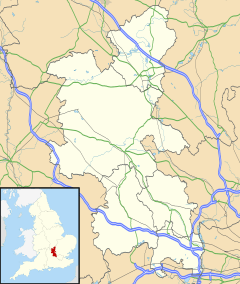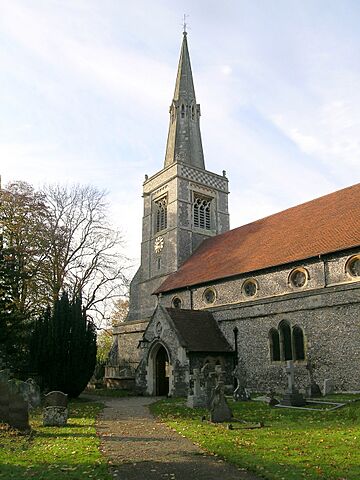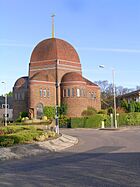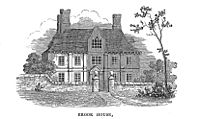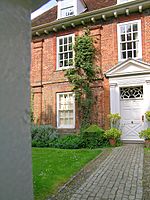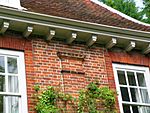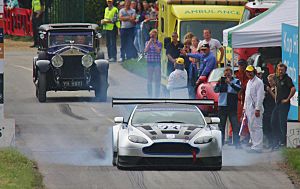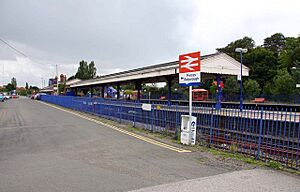Princes Risborough facts for kids
Quick facts for kids Princes Risborough |
|
|---|---|
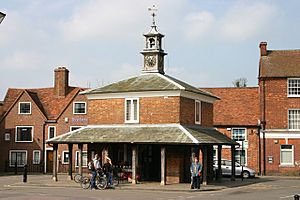 Princes Risborough Market House |
|
| Population | 7,978 8,101 (2011 Census) |
| OS grid reference | SP798030 |
| Unitary authority |
|
| Ceremonial county | |
| Region | |
| Country | England |
| Sovereign state | United Kingdom |
| Post town | PRINCES RISBOROUGH |
| Postcode district | HP27 |
| Dialling code | 01844 |
| Police | Thames Valley |
| Fire | Buckinghamshire |
| Ambulance | South Central |
| EU Parliament | South East England |
| UK Parliament |
|
Princes Risborough is a lively market town in Buckinghamshire, England. It's about 9 miles (14 km) south of Aylesbury and 8 miles (13 km) northwest of High Wycombe. The town sits at the bottom of the Chiltern Hills. It's in a natural gap through the hills, which the A4010 road follows.
Historically, Princes Risborough was a large area. It included the town and nearby villages like Lacey Green. This area stretched from Longwick in the north to Speen in the south. Since 1934, the town's official boundaries have changed. It now includes the town itself, parts of Monks Risborough, and Horsenden. The town has its own town council that helps manage local affairs.
A famous landmark overlooking the town is the Whiteleaf Cross. This is a large chalk cross carved into the hillside. It's just northeast of the town, near the village of Whiteleaf.
Contents
- What's in a Name? The Story of Risborough
- Princes Risborough: A Royal Past
- The Black Prince's Connection to Risborough
- Churches in Princes Risborough
- The Manor House: A Glimpse into History
- Markets and Fairs
- Princes Risborough Today
- Famous People and Artists from Princes Risborough
- Sports and Fun in Princes Risborough
- Getting Around Princes Risborough
- Local News and Media
- Community Life in Princes Risborough
- See also
What's in a Name? The Story of Risborough
The name 'Risborough' comes from old English words. Hrisen beorgas means 'brushwood-covered hills'. This describes the hills around the town.
In the 1200s, the town was called Magna Risberge, meaning 'Great Risborough'. This helped tell it apart from Little Risborough, which is now Monks Risborough. Later, it became Earls Risborough. This was because the land belonged to the Earls of Cornwall. After the death of Edward the Black Prince, it became Prince Risberge. Over time, it changed to Princes Risborough. This name stuck because the land belonged to different princes in the 1400s.
Princes Risborough: A Royal Past
Before 1066, Princes Risborough was a Saxon village. It was owned by King Edward the Confessor. Kings often used such royal lands to support their families or reward people. The area where the old royal manor stood is now a car park. You can still see traces of old banks and a moat there. It's thought to have been a Saxon camp.
After William the Conqueror took over England in 1066, he gave the manor to Walter Giffard, Lord of Longueville. Later, it passed to Walter's son, Walter Giffard, 1st Earl of Buckingham. When the Giffard family no longer held it, the land went back to the King.
King Henry III then gave the manor to his brother, Richard, Earl of Cornwall. After Richard's son died, the land went to his second son, Edmund. When Edmund died without children in 1300, the land returned to the Crown.
Over the years, many royal figures owned the manor. These included Queen Margaret, King Edward II's favourite Piers Gaveston, and Queen Isabella. Eventually, King Edward III gave the manor to his eldest son, Edward, who became known as the Black Prince.
The Black Prince owned the manor for 32 years, from 1344 until his death in 1376. After him, the manor continued to be passed down through the royal family. Kings like Richard II, Henry IV, Henry V, and Henry VI owned it. Queen Margaret of Anjou also held it. Later, Queen Elizabeth I owned it for her lifetime.
Finally, in 1628, King Charles I sold the manor to the City of London. This ended over 600 years of royal ownership. After that, the manor was bought and sold like any other property.
The Black Prince's Connection to Risborough
King Edward III gave the Manor of Risborough to his son, the Black Prince, in 1344. The Prince was 14 years old. He held the manor until he died in 1376. It was after his death that the town became known as Princes Risborough.
At that time, there was a manor house near the church. Old stories called it his "palace." It was likely a hunting lodge rather than a grand palace. The Prince probably visited to check on his royal stud farm. This farm was famous for breeding horses. He would inspect and choose stallions with names like Grisel and Tankarvill.
The Prince spent much of his adult life fighting in France. He won the famous Battle of Crecy. A special Council managed his manors, including Risborough, while he was away. These records show us what life was like in Risborough in the 1300s.
The manor was managed by a steward. A reeve handled daily tasks. There was also a parker, who looked after the park, and a keeper for the stud farm. Records show payments for things like ale and firewood for the Prince's household when he visited. They also mention providing hay and oats for his warhorses.
The Black Prince died in 1376 at the age of 46.
Churches in Princes Risborough
St Mary's Church
The main part of St Mary's Church was built in the 1200s. There was a smaller church here before that. The church was made bigger and better from the 1200s to the 1400s. In the 1800s, it was in poor condition. So, it was repaired and partly rebuilt in 1867–68. The tower and spire were rebuilt in 1907–08. New parish rooms were added in the 2000s.
The church has many interesting features. The main part of the church (the nave) and side sections (aisles) were added in the early 1200s. The chancel, where the altar is, was rebuilt around 1290. You can see old windows from the 1300s. In the south aisle, there's a special window with three narrow, tall openings. It's from the early 1200s.
You can also find old stone recesses that might have held tombs. Near the altar, there's a piscina (a shelf for washing sacred vessels) and a sedilia (a stone seat for the priest). These show that there was an altar here long ago.
Church Tower and Spire
The church used to have a tower and spire built in the 1400s. But the spire fell down in 1803, damaging the church. A new stone spire was built, but it was later replaced. A completely new tower and spire were built from the ground up in 1907–08.
St Teresa's Church
This unique church, with its dome, was built in 1937–38. It was designed by Giuseppe Rinvolucri. Inside, you can see painted statues and an altar relief by Richard Guino. The Stations of the Cross, which are timber carvings, were added in the 1990s.
Baptist Church
The Baptist church, off Bell Street, was built in 1804–05. It has stone walls and arched windows. Inside, there are galleries on three sides. The church has a long history, dating back to 1701. It has been extended and updated over the years.
The Manor House: A Glimpse into History
Medieval Manor House
In the Middle Ages, there was a manor house on the southwest side of the church. It was surrounded by an earth bank and a moat. Today, this area is mostly the Mount car park. Parts of the old walls were found during excavations in 1955.
The building was about 150 feet (46 m) long. The walls were made of flint and chalk. The upper parts of the walls were likely made of wychert. This is a local building material made from chalk mud mixed with straw. The roofs might have been partly thatched, but also tiled.
Archaeologists believe the building had different sections. One part was probably for the lord of the manor. Another section might have been the kitchen. The building was likely built in the 1200s. It was used throughout the 1300s, especially when the Black Prince owned it. It probably stopped being used in the early 1400s.
Modern Manor House
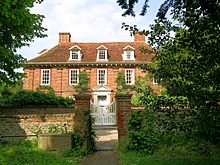
The house now called the Manor House stands across from the east end of the church. It used to be known as Brook House. Its name was changed in the late 1800s.
The house was first mentioned in 1589. It was largely rebuilt in the mid-1600s. This was when the classical Renaissance style became popular in England. The house shows this style with its balanced design. It uses brick pilasters, which are flat columns built into the wall.
The house is made of red brick and has two main floors plus an attic. The front has five windows, separated by brick pilasters. Originally, there was a large attic window. This was later replaced by three smaller dormer windows.
Inside, the staircase and some of the wood panels and fireplaces are from the 1600s. The oak staircase is quite impressive. It goes up two floors around a square opening.
In the mid-1800s, the house was in bad shape. Lord Rothschild bought it in the 1880s and had it fixed up. After this, its name was changed to the Manor House. In 1926, the Rothschild family gave the house to the National Trust. It is usually rented out, but you can sometimes visit by appointment.
Markets and Fairs
Princes Risborough has a long history as a market town. King Henry VIII granted the right to hold a weekly market and two yearly fairs in 1523. The market was originally on Wednesdays. It later moved to Saturdays and then Thursdays.
The town is proud of its market history. It's often called 'A Medieval Market Town since 1376'. This date is when the Black Prince, a famous owner of the manor, died.
Local Businesses and Shops
For the last 100 years, Princes Risborough has also been known for its local businesses. After the Second World War, many large factories opened outside the town. These provided jobs for people moving from London. Some of these included Molins Tobacco Machinery and Ercol Furniture.
Today, Hypnos Beds, a company with royal approval, is located here. Ercol Furniture also moved its main factory to Risborough in 2002.
The town also has many smaller, independent shops and businesses. Some have been in the same spot for a long time:
- The George & Dragon Pub is a very old coaching inn. It has an archway where old coaches used to park.
- The Copper Urn Café used to be next to the pub. Now it's a gift store.
- W.J Hawkins was a tobacconist. Now it's a large chemist shop. The Post Office moved to Horns Lane.
- The Cross Keys Practice, a doctor's surgery, has been on the High Street since 1918. It used to be a hotel called Cross Keys Hotel.
- Wainwright's Shoe Shop started in 1919. It moved locations several times and is no longer there.
- Padley and Binns was a chemist and optician. It's now a Lloyds Pharmacy.
- Gillingwaters, a greengrocer, is now a cooker shop.
- Steels Bakery became Speen Bakery, then a Chinese restaurant, and now a Domino's Pizza.
- The Daisy Chain florists and Letsmart Property Management are in old townhouses.
- The Shaw Trust Charity Shop was once a furniture store owned by Mr. George Ellis.
- Granny's Pantry was a café. It's now the Cinnamon Lounge Indian Restaurant.
- The PR Photos shop used to be a ladies' clothes shop. Next to it, Lightfoot Solicitors still has its offices.
- A large townhouse was demolished and replaced by three shops. These shops have changed hands many times. Now, one is a WHSmith, another is a Costa Coffee, one is an Oxfam charity shop, and the last is a pizza place.
Princes Risborough Today
Princes Risborough today includes the town and several small villages in the Chiltern Hills. These include Alscot, Askett, Cadsden, and Speen. In 1841, the town had a population of 926 people.
After the Second World War, the town grew a lot. New housing estates were built in the 1950s.
The town is home to Princes Risborough School. It opened in 1957 and is a secondary school for boys and girls. It's known as the 'Top School' because of its location on a hill.
Princes Risborough is a great place to see red kites. These birds of prey were brought back to the Chiltern Hills. You can often spot them flying over the town.
The town has appeared in several TV shows and films. These include Jonathan Creek, Inspector Morse, and Midsomer Murders.
It's a popular place for people who work in London or Birmingham. This is because it has good train links to both cities.
Famous People and Artists from Princes Risborough
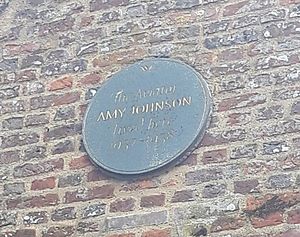
Many interesting people have connections to Princes Risborough:
- Edward Stone, a cleric who discovered the main ingredient of aspirin, was born here.
- Jabez West (1810–1884), a political reformer, grew up in the town.
- Nigel Harrison, a musician from the band Blondie, went to school here.
- Sarah Harding, a singer from Girls Aloud, used to live in Cadsden.
- Jay Kay, a musician from Jamiroquai, lives in Horsenden.
- Martin and Paul Kelly, musicians from the band East Village, grew up here.
- The indie-rock band Tiger started in Princes Risborough.
- Lee McQueen, who won The Apprentice TV show, is from here.
- Nicholas Parsons, a famous broadcaster, lived in Ilmer until he passed away.
- Amy Johnson, a pioneering pilot and the first woman to fly from England to Australia, lived in Princes Risborough from 1937 to 1938.
Sports and Fun in Princes Risborough
Motorsport: The Kop Hill Climb is a very old car and motorbike event. It ran from 1910 to 1925. It was brought back in 2009 as a celebration of classic and modern vehicles. Thousands of people visit each year. It has raised over £600,000 for charity! Famous people like Mary Berry and Jay Kay have supported it.
Cricket: Princes Risborough Cricket Club plays at Windsor Playing Fields. Monks Risborough Cricket Club has a pitch nearby.
Football: Risborough Rangers football club is based at Windsor Playing Fields. They have many teams playing in the town.
Golf: There are several golf courses nearby. These include Princes Risborough Golf Club and Whiteleaf Golf Club.
Tennis and Bowls: Princes Risborough Bowls Club and Princes Risborough Lawn Tennis Club have their own grounds.
Rugby: Risborough Rugby Football Club was started in 2008. They use the Whiteleaf Pub as their clubhouse.
Swimming: You can go swimming at Risborough Springs, an indoor pool. Next to it is Wades Park, with a playground and basketball court.
Princes Risborough also has a recreation ground called King George's Field. It's a memorial to King George V.
Getting Around Princes Risborough
Trains
Princes Risborough railway station has train services run by Chiltern Railways.
- Trains go between London Marylebone and Oxford. They usually run twice an hour.
- There's also a shuttle train to Aylesbury.
You can also ride on heritage services from the Chinnor and Princes Risborough Railway to Chinnor.
Buses
Local bus routes are run by several companies. They connect the town to Aylesbury, Chinnor, High Wycombe, and Oakley.
Local News and Media
You can watch local TV news from BBC South and ITV Meridian. For radio, you can listen to BBC Radio Oxford and BBC Three Counties Radio. Other local stations include Heart Thames Valley and Red Kite Radio. The Bucks Free Press is the town’s weekly local newspaper.
Community Life in Princes Risborough
The Princes Risborough Town Council works to help both residents and visitors. Their website has useful information for anyone wanting to explore the town. The Council wants everyone to enjoy what Princes Risborough offers.
The Risborough Area Partnership (RAP) brings together local businesses, government, and community groups. They organize many community events throughout the year.
See also
 In Spanish: Princes Risborough para niños
In Spanish: Princes Risborough para niños


